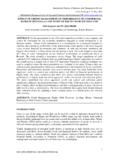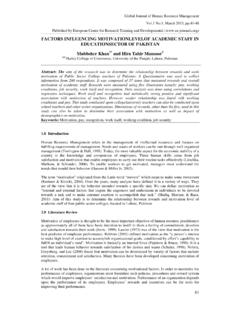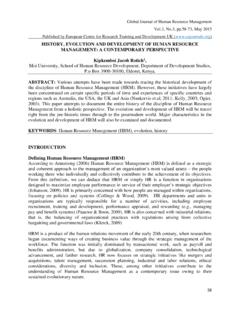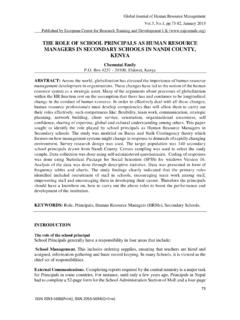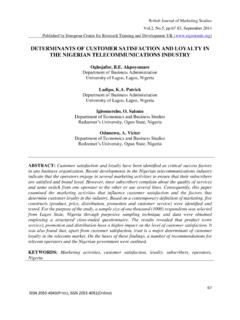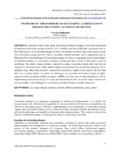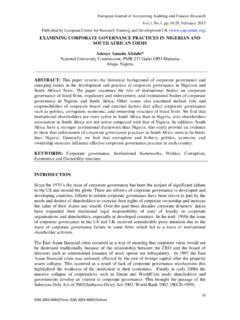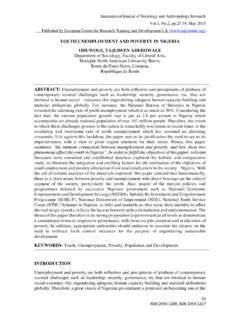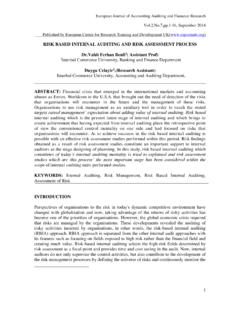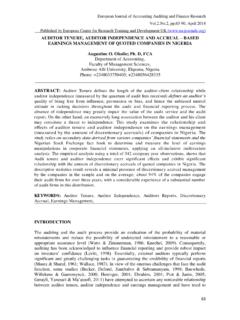Transcription of Organization Development Models: A Critical Review and ...
1 European Journal of Training and Development Studies , , , September 2015 ___Published by European Centre for Research Training and Development UK ( ) 29 ISSN 2057-5238(Print), ISSN 2057-5246(Online) Organization Development Models: A Critical Review and Implications for Creating Learning Organizations Maxwell. A. Asumeng and, Judith Ansaa Osae-Larbi Department of Psychology, School of Social Sciences, College of Humanities, University of Ghana. P. O. Box LG 25. Legon-Accra. Ghana ABSTRACT: Over approximately the last 20 years, models have been used to guide the Organization Development (OD) consulting process for enhanced organizational effectiveness, with implications for creating learning organisations. This Review analyses and synthesizes the characteristics, similarities and differences, and strengths and weaknesses of four main models of OD, and the extent to which they can be used to create learning organisations. The models reviewed are the three-step, action research, appreciative inquiry, and the general planned change model.
2 Whereas all four models overlap in characteristics such as involving participants in the change process, important differences including the focus and stages of change exist amongst them. On the basis of the Review , the general model of OD which integrates the other three models is revised and extended to address two main gaps. The first is the absence of a stage in the change process that focuses on assessing pertinent organizational and client factors capable of influencing the success/failure of planned change efforts. The second concerns the lack of clarification on how organizations can become learning organizations as part of the change process. The proposed extended general OD model comprises six overlapping stages, including a final empowering-withdrawal stage. It proposes that OD efforts should empower clients to become learning organizations as an ultimate focus of the field of OD.
3 The Review holds important implications for OD practitioners and researchers to jointly adopt, Review , and build on the proposed revised general model of OD. KEYWORDS: Organization Development , Organizational Learning, Learning Organization . INTRODUCTION From its beginning in the early 19th century, various change models have been proposed to guide the core purpose of the field of Organization Development (OD) to plan and implement change in order to promote organizational effectiveness. Although they may not explain every situation in the real world, these models provide the grounds on which change agents might proceed with designing, planning, and implementing change . During approximately the last twenty years, the use of models to guide the OD consulting process has been associated with enhanced organizational effectiveness through the adoption of one or a combination of change intervention strategies which are: human process-based strategies, techno-structural strategies, socio-technical strategies, and organizational transformation strategies (Mulili & Wong, 2011; McLean, 2005) Organizational change , Development , and learning organizations All OD change intervention strategies may lead to some form of organizational learning such as knowledge acquisition, gaining of insight, and habit and skill learning (Mulili & Wong, 2011).
4 Unfortunately, not all intervention strategies can result in the creation of a learning European Journal of Training and Development Studies , , , September 2015 ___Published by European Centre for Research Training and Development UK ( ) 30 ISSN 2057-5238(Print), ISSN 2057-5246(Online) Organization . A learning Organization is an Organization that seeks to create its own future; that assumes learning is an ongoing and creative process for its members; and one that develops, adapts, and transforms itself in response to the needs and aspirations of people, both inside and outside itself (Navran Associates Newsletter, 1993). Such an Organization therefore seeks to continuously improve itself as a whole, by proactively adopting organizational leaning activities in order to effectively manage both internal and external change situations ahead of time (Cummings & Worley, 2009). It is important that these two concepts organizational learning and a learning Organization are not confused or used interchangeably, as there exists important distinctions between the two.
5 In their Review of the importance of organizations in continuously adopting OD efforts, Mulili and Wong (2011) underscored the fact that organizational learning is a learning process that naturally exists in all organizations without any planned efforts. On the other hand, a learning Organization was described as a type of Organization that requires conscious effort on the part of the whole system to be established. Perhaps, a more concise distinction is that reported by Schein (1996), which described organizational learning as learning by individuals and groups IN the Organization and a learning Organization as learning BY the Organization as a total system. The advantages associated with the creation of learning organizations cannot be underestimated. It enhances organizations capability to meet the ever changing and complex needs of clients. It also gives organizations a sustained competitive edge over other organizations.
6 In addition, successful translation of knowledge gained from continuous learning into new products and services, can allow learning organizations to constantly create new sources of wealth (Cummings & Worley, 2009). In fact, it is argued that learning organizations are an important hallmark of OD efforts that distinguish the field from that of change management . In effect, organizations and change agents may focus on a number of outcomes as a measure of the OD change process. However, the creation of learning organizations, which has emerged over the years as an ultimate focus of the field of OD, must be targeted not only as a desirable outcome, but an imperative one. Considering the value of organizations in becoming learning organizations, a Review of the models that typically underpin the OD change process, is but a noble course. This would help ascertain the suitability of existing models in guiding change agents to form learning organizations as part of the OD consulting process.
7 Other vital reasons support the Review of OD models. Comprehensive models guide successful planned interventions, which are necessary to promote not only organizational structures and procedures, but also the quality of work life of organizational members. The ever-changing needs and nature of organizations, in part due to advancements in technology, also support the continuous appraisal of planned change models in order to ensure that the general model of OD is always comprehensive and relevant to the complex and dynamic needs of its clients. The purpose of this Review therefore, is to appraise four of the main models utilized in the field of OD to guide planned change processes, and their implications for creating learning organizations. Specifically, a brief overview of organizational change models as well as the key characteristics of the three-step model; the action research model; appreciative inquiry model; and the general model of planed change will be presented.
8 The similarities and differences in the characteristics of the models, as well as their strengths, effectiveness and weaknesses will be analysed with an attempt to synthesize and draw out the core and relevant components/characteristics into a more comprehensive model. Drawing on the analysis of the European Journal of Training and Development Studies , , , September 2015 ___Published by European Centre for Research Training and Development UK ( ) 31 ISSN 2057-5238(Print), ISSN 2057-5246(Online) models, the Review will end with implications for the creating of learning organizations as part of the OD consulting process. Recommendations for evaluating and enhancing the adoption of a proposed model in a way that would help to foster greater integration between theoretic and practitioner-generated knowledge, particularly, in the creation of learning organizations would then be presented. ORGANISATIONAL Development MODELS Overview of Organisational Development Models Conceptually, organizational change approaches are based on two main theories: change process theory and implementation theory.
9 The former concerns the dynamics of the change process (how and why change occurs), whereas the latter addresses how actions generate change and what actions can be taken to initiate and guide change (Austin & Bartunek, 2003). Each theory encompasses different categories of change theories which are further comprised of many different individual models. For instance, implementation approaches include four primary theories or motors for initiating and guiding change . According to Austin and Bartunek (2003), these are the participation, self-reflection, action research and narrative motors of changing. Similarly, change process theories, according to a classification by Van de Ven and Poole (1995), include four main categories or motors of change ; the teleological, dialectical, evolutionary, and life cycle motors. A key distinction between change process and implementation approaches is the fact that the former are largely developed by academics, whereas the latter are largely developed and utilized by practitioners.
10 Models of OD ( appreciative inquiry model) are individual models guided by assumptions from one or a combination of motors (Austin & Bartunek, 2003). Indeed, most organizational change models tend to be primarily influenced by either change process or implementation theories, although this approach often threatens the focus of OD in fostering greater integration of theoretic and practitioner-generated knowledge (Burnes & Cooke, 2012). For instance, the four models under Review tend to be largely implementation theories, as they guide the process/phases through which change occurs and/or explain the sets of activities necessary to bring about change at each phase (Austin & Bartunek, 2003). However, some models ( the action research model), may draw on assumptions from a combination of change process and implementation motors. In this Review , the phases through which organizational change unfolds as described by Lewin s three-stage model, the action research model, the appreciative inquiry model and the general model of planned change are presented.
